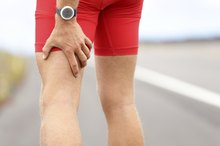What does fact checked mean?
At Healthfully, we strive to deliver objective content that is accurate and up-to-date. Our team periodically reviews articles in order to ensure content quality. The sources cited below consist of evidence from peer-reviewed journals, prominent medical organizations, academic associations, and government data.
- Harvard University Press: Hand Grip and Hypertension
- National Institutes of Health: High Blood Pressure
The information contained on this site is for informational purposes only, and should not be used as a substitute for the advice of a professional health care provider. Please check with the appropriate physician regarding health questions and concerns. Although we strive to deliver accurate and up-to-date information, no guarantee to that effect is made.
Hand Grip Exercises & Blood Pressure
High blood pressure -- also called hypertension -- affects the circulatory system and is characterized by high blood pressure on the arterial walls that may eventually cause more severe medical problems, such as heart disease, heart attack or stroke. According to the Mayo Clinic website, you may go for years with hypertension without realizing it. It is easily diagnosed and once discovered is managed with prescription medication, exercise, diet and lifestyle changes.
If you are experiencing serious medical symptoms, seek emergency treatment immediately.
History
According to Harvard Health Publications, isometric hand grip exercises were first used in the mid-1970s to protect fighter pilots from blacking out while making turns and dives. The G-force acceleration of the fighter jets made it difficult for the pilots' hearts to pump enough blood to the brain, thus causing the pilot to lose consciousness. Dr. Ronald Wiley discovered that by using isometric hand grip exercises, the pilots could increase their blood pressure enough to stay conscious. He also discovered that the pilots who consistently used the hand grip exercises had also decreased their resting blood pressure -- a finding that has been replicated in numerous studies, allowing researchers to speculate that isometric hand grip exercises can lower high blood pressure.
- According to Harvard Health Publications, isometric hand grip exercises were first used in the mid-1970s to protect fighter pilots from blacking out while making turns and dives.
- Dr. Ronald Wiley discovered that by using isometric hand grip exercises, the pilots could increase their blood pressure enough to stay conscious.
Hand Grip Exercises for Hypertension
Isometric Hand Grip Exercises
Learn More
Several machines replicate the hand-grip motions that lower high blood pressure. Wiley created the first hand-grip tool, CardioGrip; it was large, boxy and expensive. The Zona Plus, replaced Wiley's machine and is used today. The FDA-approved Zona Plus is as small as an electric razor, and costs $300, as of 2010. The price keeps this device out of many patients hands since it is not yet covered by Medicare or other health care plans.
- Several machines replicate the hand-grip motions that lower high blood pressure.
- Wiley created the first hand-grip tool, CardioGrip; it was large, boxy and expensive.
Isometric Ball Exercise
A cheaper alternative suggested by the National Institute on Aging uses a simple tennis ball or other foam or rubber ball. Grip the ball in your right hand and squeeze it as hard as you can for 5 seconds and release. If you cannot squeeze the ball for the required time, work up to it. Repeat the gripping motion 10 to 15 times and switch to the left hand. Repeat another set of 10 to 15 repetitions on both hands.
- A cheaper alternative suggested by the National Institute on Aging uses a simple tennis ball or other foam or rubber ball.
- Repeat the gripping motion 10 to 15 times and switch to the left hand.
Research
Thumb Range of Motion & Strengthening Exercises
Learn More
According to Harvard University all of the hand grip exercise studies thus far have been small and short, but the findings have been very similar 1. After using hand-grip exercises, a number of participants showed a significant decrease in their systolic blood pressure of 14 points on average. Although more research must be concluded, these initial findings suggest that hand-grip exercises are as effective at lowering high blood pressure as anti-hypertension drugs.
Considerations
Hand-grip exercises are not a quick-fix for high blood pressure. You must practice the exercises consistently for five to six weeks before any changes are apparent. Also, the exercises must be practiced regularly or you may find your blood pressure rates creeping back up again. Hand-grip exercises are not a replacement for regular cardiovascular exercise, so be sure to add walking, swimming, gentle aerobics and yoga into your daily routine.
- Hand-grip exercises are not a quick-fix for high blood pressure.
- Also, the exercises must be practiced regularly or you may find your blood pressure rates creeping back up again.
Related Articles
References
Writer Bio
Nicole Carlin is a registered yoga teacher. Her writing has been published in yoga and dance teacher training manuals for POP Fizz Academy. Carlin received a Masters of Arts in gender studies from Birkbeck University in London and a Bachelors of Arts in psychology from Temple University, Philadelphia.









